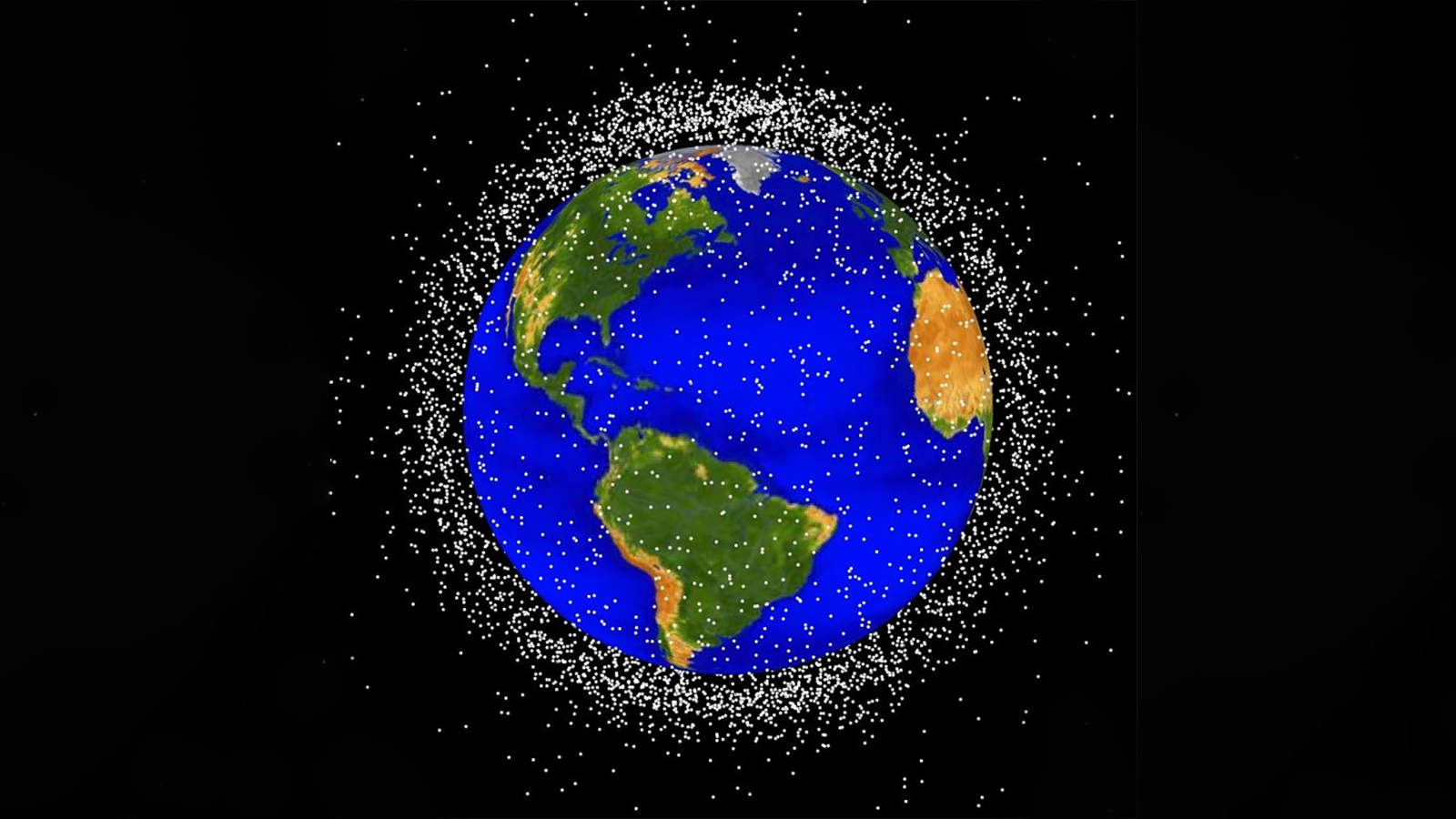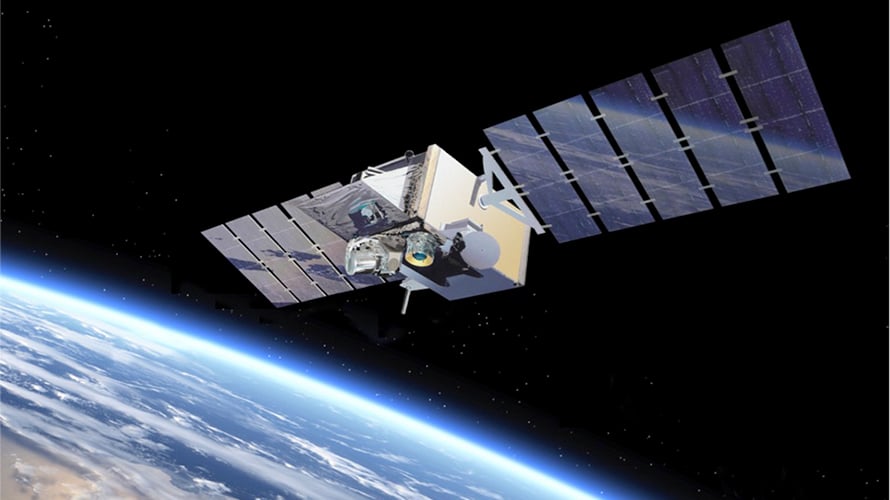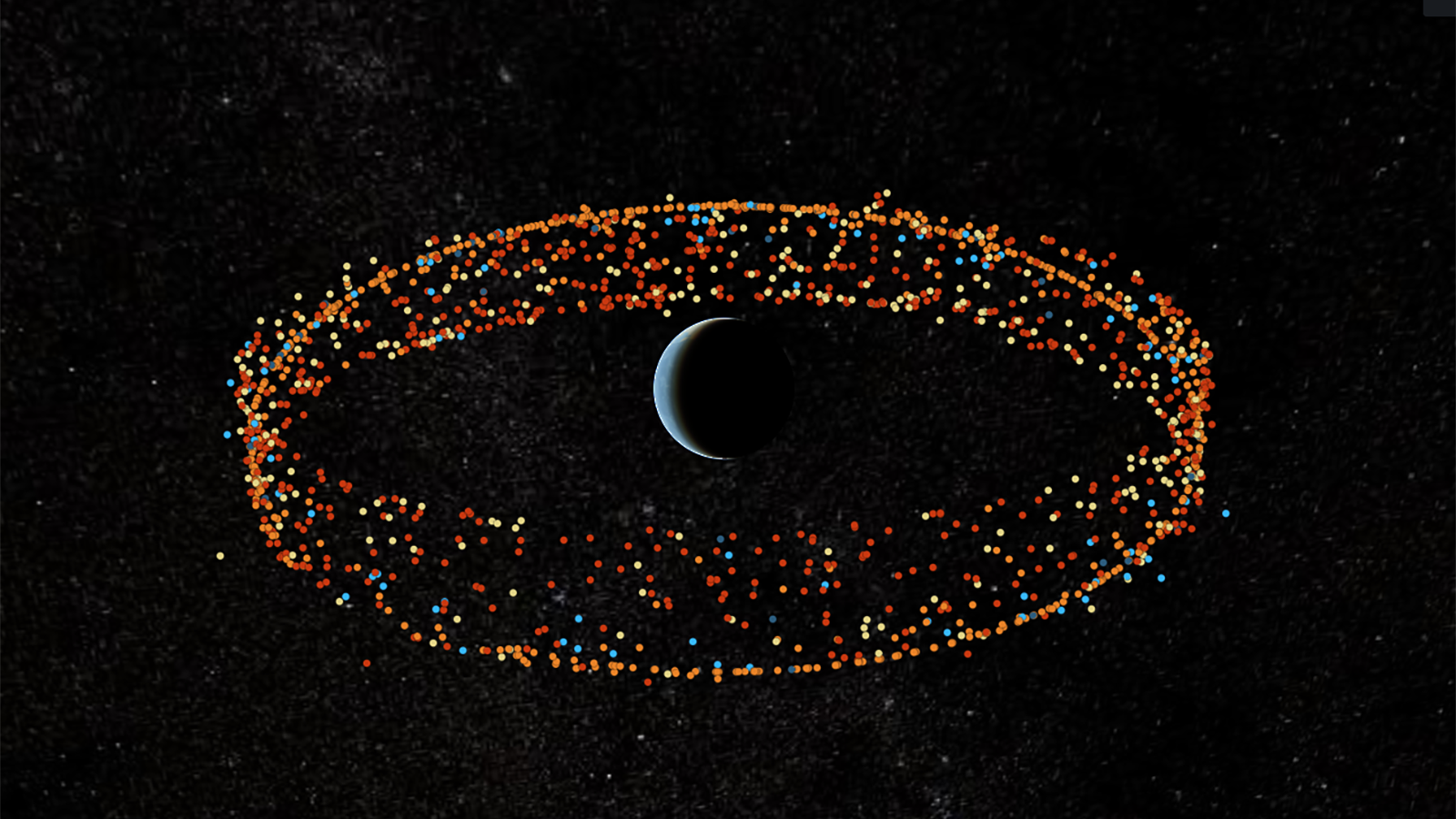
Space Command currently is keeping tabs on more than 44,000 satellites and pieces of space junk. (NASA image)
SPACE SYMPOSIUM: The Pentagon’s long-troubled effort to replace and modernize its outdated information technology systems for keeping tabs on satellites, spacecraft and dangerous space junk finally seems to be turning a corner after two decades and nearly a $1 billion spent. The latest sign: Space Force officials say that two new systems for data processing, called ATLAS and Warp Core, are nearing fruition.
But outside experts and former defense officials told Breaking Defense they’re still concerned about the the pace of the effort and a lack of visible progress toward modernization. Likewise, in its latest report on the effort, issued in December, the Government Accountability Office (GAO) raised concerns about a lack of transparency, as well as shifting acquisition plans and changing program objectives.
The reliance on old IT has hampered the ability of the military and Intelligence Community to rapidly and accurately assess potential on-orbit threats, whether from adversary space activities or out-of-control space junk — a problem that’s only getting bigger by the day.
RELATED: Key space monitoring sensors still rely on outdated CAVENet computer system
“This does seem like progress,” one former Air Force space operator said of the coming new software while noting that there are aspects of the highly complex program that continue to “raise some questions in my mind.”
How SDA Does (And Doesn’t) Work
The ability to detect, track and understand what is happening in space, especially with regards to potential threats from adversary satellites, is what the Defense Department now dubs “space domain awareness” or SDA.
“SDA helps us analyze not just identify what is occurring and space, which when combined with information from our intelligence agencies, helps develop an understanding of why things are happening in space. SDA remains my top mission priority for US Space Command,” Space Command head Gen. Jim Dickinson told the House Armed Service’s strategic forces subcommittee on March 1.
To do that, the military relies on its Space Surveillance Network (SSN) comprising ground- and space-based radar and telescopes. This sensor network can detect objects bigger than five centimeters in Low Earth Orbit (between 100 and 2,000 kilometers above sea level), and bigger than a meter in Geosynchronous Orbit (36,0000 kilometers).

Space Tracking and Surveillance System (STSS) tracks missiles from orbit
But it also requires computers and software to gather, manage and analyze that sensor data to figure out what those things are and provide their on-orbit coordinates, as well as to run software models to predict the likelihood of potential orbital collisions before they happen. Finally, it requires rapid processing of all that data into actionable information about on-orbit threats that can be transmitted in near real-time to SPACECOM personnel who are charged with the wider mission of command and control — and protection — of US military satellites.
The Space Force’s Space Command and Control (Space C2) program, nicknamed Kobayashi Maru after the Star Trek franchise’s fictional cadet training simulation without a solution, is in charge of DoD’s latest effort to modernize, and automate via machine learning and artificial intelligence, those SDA information technology systems for Space Command’s use.
Space C2’s “SDA portfolio” of work encompasses a handful of complex and intertwined hardware and software development projects, some being undertaken by Space C2 personnel and some by outside contractors — all designed to replace and improve upon the infamously flawed Joint Space Operations Center (JSpOC) Mission System (JMS).
The JMS program, begun in 2009, was supposed to have three planned “increments” of hardware and software upgrades to be implemented though a series of “service pack, or SP” upgrades. But after a decade of effort and not quite $1 billion in spending, JMS was killed in 2018 — in the middle of Increment 2, JMS SP-9. Col. Rhet Turnbull, SSC’s head of Cross Mission Ground & Communications Enterprise, told Breaking Defense in an email that testers discovered “critical issues” in JMS SP-9 that prompted the “pivot” to the Space C2 program in 2019.
It also meant that Space Command has continued to limp along using the outdated systems, including two in particular at the heart of SDA capabilities that JMS was supposed to replace:
- The 1980’s-era Space Defense Operations Center (SPADOC) computer system and software that is used to populate the publicly available Space-Track.org database, which currently contains general orbital positioning data about some 44,000 space objects. The SPADOC system links directly with the SSN sensors to “pull down” data and process it.
- The 2000’s-era Command, Analysis, Verification and Ephemeris Network (CAVENet) computer system used to calculate possible collisions with much higher accuracy, including for NASA and the National Reconnaissance Office. It runs the Astrodynamics Support Workstation (ASW) software that allows more accurate determination of a space object’s whereabouts, as well as providing estimates of the error in those determinations — data that is used to create the military’s more accurate, and classified, catalog of space object data. CAVENet is a stand-alone, off-line system that does not link directly with SSN sensors.
From JMS To ATLAS And Warp Core
Space C2’s current SDA effort isn’t just attempting a make-over of JMS, however.
“The original JMS requirements are over a decade old, which is one reason modernization is needed. Space C2 is developing and delivering the modernized capabilities needed today for the SDA mission. This includes Warp Core and ATLAS, as well other capabilities for our warfighters,” Turnbull said. “In the past three years, Space C2 has developed and delivered 11 operationally-accepted capabilities that currently support warfighter operations.”
“In the Space C2 program, we are focused on applying many of the lessons learned from JMS, including the importance of making data accessible to the right users at the right classification level at the right time as well as providing tools to our operators that facilitate enhanced operations,” said Col. Chris Kadala, senior materiel leader for Space C2.
For example, he said, “lessons learned” from JMS Increment 2 led to the development of Warp Core.”
 Space Force on Jan. 26 announced that it had taken first steps towards decommissioning JMS SP-9 after taking “operational acceptance” of the Warp Core software, developed by Palantir.
Space Force on Jan. 26 announced that it had taken first steps towards decommissioning JMS SP-9 after taking “operational acceptance” of the Warp Core software, developed by Palantir.
And that decommissioning will be a good sign, said several experts versed in Space Command’s SDA systems.
“This will give … a commander a broad understanding what’s happening from a variety of different sensors, and that’s a good thing,” said the former Air Force official.
Warp Core is a multi-layer software tool for data management that performs a number of functions, but in particular it rapidly integrates data taken from multiple source systems — in the case of SDA, the various SSN sensors — to extract their data, and, in essence, translate it into a user-friendly form.
Palantir’s contract for Warp Core’s SDA applications is worth about $24 million, as part of a larger contractual package with SCC totaling $91.5 million that covers use of different iterations of the software tech stack for two other Department of the Air Force projects.
“Warp Core has enabled — via software — true domain awareness for the Space Command and Control Mission on an accelerated timeframe,” said Akash Jain, president of Palantir’s US government business. “It has also contributed to greater DoD and US Government needs as demonstrated during the Non-Combatant Evacuation operation in Afghanistan.”
Warp Core will serve as the data layer for ATLAS, the Advanced Tracking and Launch Analysis System being developed by L3Harris, that will eventually replace SPADOC — which Gen. Jay Raymond, who currently heads Space Force, called an “old clunker” way back in 2017.
“Due to the number of sensors, observations and data points, Warp Core provides a critical service by integrating and streamlining data for ATLAS,” Turnbull said.
“ATLAS leverages this data to provide multiple integrated capabilities,” he added, “including automated processing and maintenance of the space catalog of all known space objects; manual and automated observation association, orbit determination, and propagation of general perturbation and special perturbation; manual and automated uncorrelated track processing; event processing; manual and automated uncorrelated track processing; tasking and calibration; and processing of satellite conjunctions.”
In other words, it’s designed to identify detected objects, put them in the unclassified and classified catalogs, track their orbits and make accurate predictions about possible collisions.
Another SSC official told Breaking Defense in an email that “ATLAS and Warp Core will replace SPADOC and the SPADOC Emulation Analysis and Risk Reduction (SPEARR) functionality over the coming year.”
SPADOC is old enough that it can’t handle much of the complex processing it needs to do, so Space Force uses SPEARR, developed by Raytheon under a 2019 contract, to re-host the code on more modern computers. This has allowed much of SPADOC data to be processed faster by offloading it to SPEARR, and SPADOC’s limited processing power to be used only for the functions (for example, tasking older sensor systems) that couldn’t be offloaded.
ATLAS is “all about maintaining the high accuracy catalog of where all the objects are out in space,” explained a L3Harris official. And key to that is automating the processing to reduce the burden on operators as the number of objects in space continues to grow exponentially, the official added.
L3Harris has been funded $35 million since 2019 for ATLAS mission application development, and was awarded a new two-year award worth $49.7 million in December 2021.
ATLAS is an agile software development program focused on rapid, incremental delivery of “minimum viable capabilities,” or MVCs, required for decommissioning of SPADOC. MVCs are essentially initial features that can be fielded for operational use, a Jan. 25 Space Force press release explained.
Turnbull said the first of those MVCs “are planned for delivery and operational acceptance” this year.
Yet More Moving Parts: Hyperion, Osiris and Iris
But updating monitoring capabilities for today’s more congested and contested space environment requires more than simply replacing SPADOC.
“Space C2 is replacing SPADOC while simultaneously modernizing Space Domain Awareness (SDA) capabilities for the Space Force,” the SSC official noted. “The SDA portfolio within Space C2 consists of ATLAS, Hyperion, Osiris, and Iris. … Hyperion, Osiris, and Iris are other modernization efforts designed to enhance SDA capabilities.”
Lt. Col. Reggie Shelton, Space Systems Command’s Cross Mission Ground & Communications materiel leader of the Space C2 SDA Branch in Kobayashi Maru, explained the latter three projects in an email:
- Hyperion is a modernization effort to improve sensor calibration processes, including automation, timeliness of sensor calibration, enhanced data products, refined sensor accuracy models, and near real-time monitoring of government and commercial systems for anomaly detection. The goal for the Hyperion applications is to deliver robust web-based applications to continually evaluate and monitor sensor data across the space domain. Hyperion is intended for users who want to ensure data quality, integrity, and reliability across a vast sensor portfolio.
- Osiris is a technology refresh effort that will provide advanced integrated processing, analysis, and decision support tools for the Space Domain.
- Iris is intended to provide a single, bi-directional messaging interface amongst various Space Domain Awareness C2 systems/sensors.
All of these projects are still works in progress, however, and observers have complained that for all the high expectations, specific information about how the updates are coming along is hard to come by.
As GAO pointed out, it’s actually extremely difficult to judge from Space Force annual reports on the Space C2 program — required by Congress the 2019 National Defense Authorization Act — what exactly has been accomplished.
The “usefulness of these annual reports for oversight is limited because they lack information needed to provide a more complete picture of the status of the Space C2 program,” GAO found.
Another problem is that the reports do not include any feedback from users on what operational benefits are accruing from the various sub-projects involved in Space C2’s SDA portfolio.
Meanwhile, Space Command for the moment is still reliant on SPADOC and especially CAVENet. For example, the latter, which has over the years taken on more and more of SPADOC’s older functions, is still required for integration of observational data from the newest SDA sensor, the Space Fence ground-based radar. When that will change is currently unclear.






















